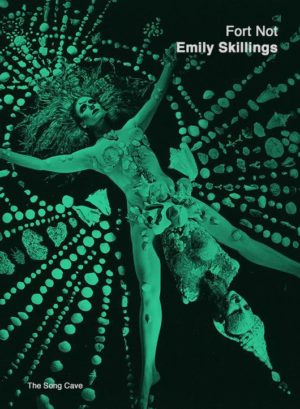In Their Own Words
Emily Skillings on “Matron of No”

Matron of No
There are so many paintings of Lucretia
stabbing herself and they're all
pretty terrific. My personal favorites
are the ones where she looks bored (Rembrandt,
Parmigianino, Sellaer, Cranach
the Elder) like she's just sticking
a casual reminder
between her tits that life is suffering,
and a certain quota of daily blood
is needed for a decant into that ancient
ceremonial chalice of feminine shame. Drip
drip. Reclining on a sofa in the mid-century style
I allow a stranger's black-and-white boy cat
with bright pink rubber caps on all its claws
and a clipped tail to knead a soft space, this shelf
of fat above my organs. It feels invasive
but not unpleasant, a therapy
taken in foggy discomfort.
Caught in my phone's own beam
is my greasy face, which, downturned,
admires the Expressionist skyscraper
proposed but never built
by Ludwig Mies van der Rohe
for Berlin's Friedrichstraße, its points
pointing at an overgrowth in me,
my finger hovering over the street,
no vehicles below, no people,
the black smudge of city movement
implying by erasure
those who move
through its striated, dynamic soot.
And what of the top? A blade garden.
Full of women seeking aesthetic revenge.
I think I might like to go away.
I think I might like to bond
with the darkest stuff, revisit the peeling corner
that exists in almost every room
and is exquisite artwork that nobody looks at—
to sit with it awhile until a feeling of lateral
motion takes over, a whisk
into a syncretion of senses
from different legendary themes.
And now the cat is on the dining room table
licking goat cheese from an earthenware bowl.
The big windows let the night in on a timer.
The room does its thing to me again.
"Your lips / your eyes." That gentle shuffle
of petals across the brain.
From Fort Not (The Song Cave, 2017). All rights reserved. Reprinted with the permission of the author.
On "Matron of No"
I wrote this poem on my phone in someone else's house. I was feeling bored and kind of physically gross, like I needed a shower. I went to take a picture of the cat and the camera accidentally turned on my face, a contemporary occurrence that, to my horror, happens to me almost daily. You attempt to capture something outside yourself and the aperture focuses inward. This is also sometimes what happens when one sets out to write, we aim outside to eventually go inside.
I was housesitting, and I often feel that being in a space inhabited and designed by another person, being around other people's stuff, allows me a new way of associating. It is extremely luxurious to be surrounded by new things, the furniture in exciting configurations, disorienting relationships among surfaces, new colors and objects to be with, live in. Even the body is forced to create new pathways of being and moving in unfamiliar domestic spaces. You get tuned differently. Though inspiring, it's never quite comfortable. In his terrific essay "On Housesitting," Brian Blanchfield calls this having "a vacated life to try on."
This new space got me thinking about some images I've always loved and returned to, including an illustration of a tower designed by Mies Van der Rohe—a MoMA postcard version of this moody little sketch, entitled "Wabe" (Honeycomb), from some Bauhaus exhibit, hung above my writing desk for some time—and also the many classic paintings of Lucretia "in the act" of inflicting a small dagger upon her breast. I've always been so tickled by the gaze in many renditions of this scene, how she sometimes looks bored even in the wake of her own tragedy. There is rarely a convincing glimpse of pain in her expression. I once confessed my fascination with this to an art history student I very briefly dated and he corrected me, saying that the Lucretia's physiognomy in these examples was just a result of the painting style of the period, and that I should not read into her apparent emotional detachment. Whatever! The sharp geometry of the building and the point of the dagger seem to reach me in a similar way.
In one of the rooms in Dodge Hall where I had many of my graduate classes, there was a corner where an old radiator met a wall on which the paint was consistently, almost vigorously, peeling back in curled strips. I would always "check in" with it in class, in moments where I felt detached or uninterested. It became a kind of landmark for my thinking, a visual touchstone, and I would often relate it to the material being discussed. I was happy to be able to land on it in my own writing, to know that I could find it not only in memory, or in this poem, but also in new rooms I hadn't yet visited.
The beginning of the poem, a friend pointed out to me, seems indirectly or subconsciously influenced by the list of painters at the onset of John Ashbery's "Caravaggio and His Followers," which could be true.
I am not really sure what to make of these convergences of images. I know I couldn't have written the poem anywhere else. The room was very dark, and the dark was almost velvety, and I could see my own apartment building from its large windows. The couch was handsome. I was feeling a little slighted by a man. The phrase "does its thing to me" is the only way I could write "has its way with me," which is actually closer to what I meant but felt like a disgusting thing to put in a poem.
After searching for ages for a last line that would fit, I decided to lob off the last couplet. The last line in the published version feels penultimate to me. The first line of the, now absent, couplet was "I'm no longer concerned with picture quality." I reread Canto IV of the Inferno looking for something to end on, convinced it would be imbedded in the lines dedicated to the virtuous and renowned unbaptized of limbo's trembling "eternal air" (in which Lucretia is briefly glimpsed) but it never showed its face. As a result, the poem feels pleasantly incomplete.



